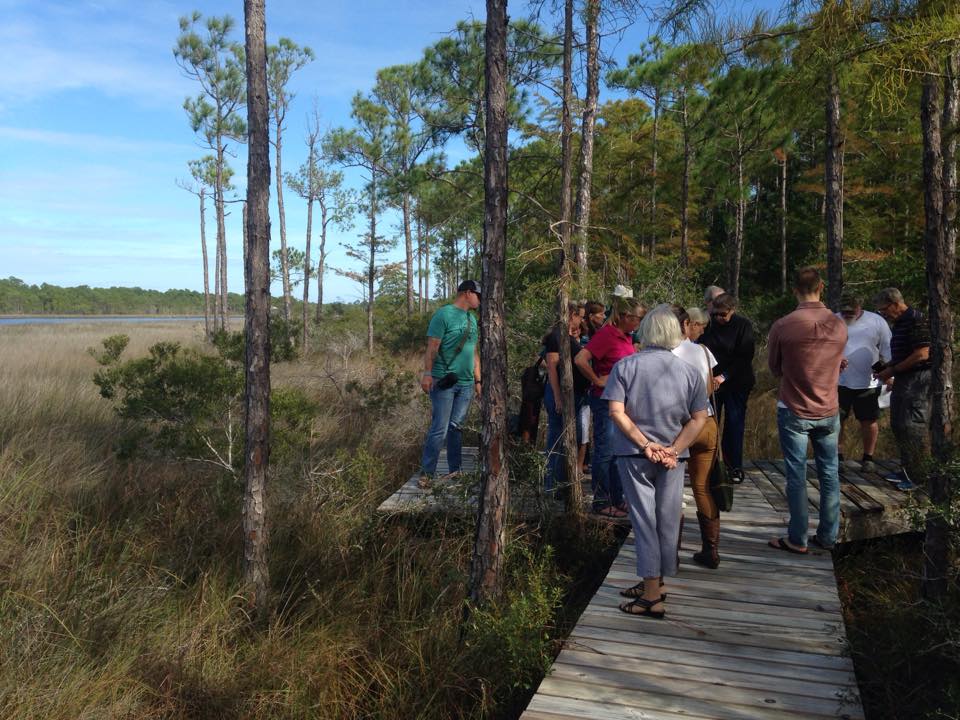
by Carrie Stevenson | Feb 3, 2016
Do you love the outdoors? Wish you knew more about the plants and animals native to our area?
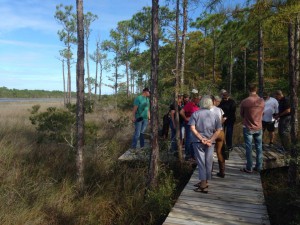
Master Naturalist Jerry Patee leads classmates along his project: a wetland boardwalk in Perdido Key. Photo credit: Carrie Stevenson
The Florida Master Naturalist Program is a course offered by Extension agents throughout the state, including the northwestern counties. Three different modules—Freshwater Wetlands, Coastal, and Uplands—are offered. They include 40 hours of instruction time on ecosystems, plant identification, animal ecology, and how humans live within the environment. Each class includes 2-3 field trips which may entail hikes, paddling, or tours of local museums and parks. Adult students are expected to produce an educational project at the end of the course, which may vary from a display or presentation to a skit or full-blown nature trail.
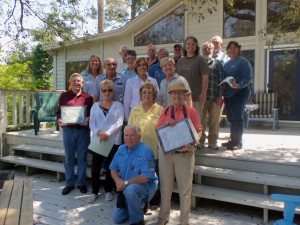
Proud Master Naturalist students at their graduation. Photo credit: Carrie Stevenson
Several Master Naturalists have recently brought their projects to life. Several years ago, Charlie Lurton created a plan to build living shorelines in Bayou Grande behind homes in his neighborhood. The project was approved by state and federal environmental regulatory agencies and oyster reefs and planting have recently begun. Jerry Patee, also an Escambia County Master Gardener, worked with his church to create a boardwalk trail through wetlands to a pristine view of Bayou Garcon in Perdido Key.
Master Naturalist students vary in backgrounds from retired military and teachers to new residents and college students. Many Master Gardeners find the courses a helpful addition to their training, and utilize their newly gained knowledge when working with clientele. At completion, students receive an official Florida Master Naturalist certificate, pin, and patch. Several Panhandle courses will be offered this spring—check out the FMNP website to see when a class will be offered near you!
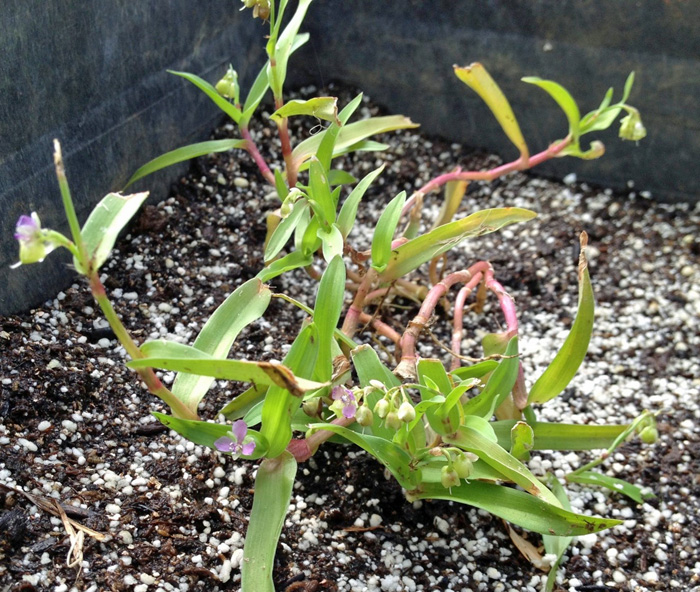
by Carrie Stevenson | Dec 4, 2015
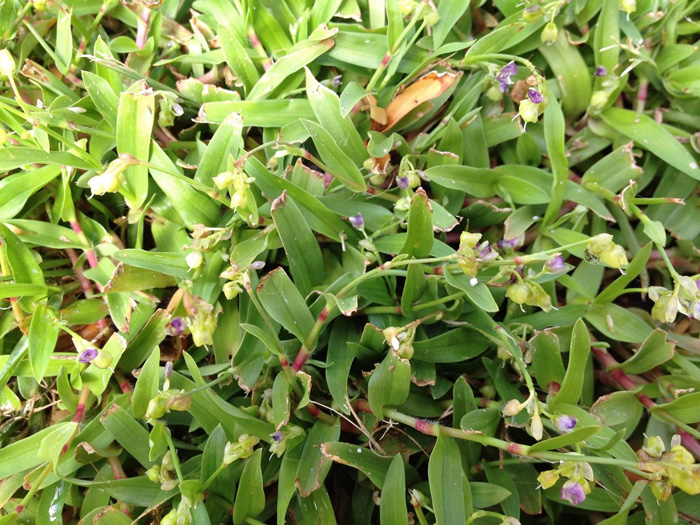
______________________Figure 1. Doveweed patch in St. Augustinegrass sod.__________________________
Ramon Leon, WFREC Weed Specialist
Doveweed (Murdannia nudiflora) is a summer annual weed species that belongs to the dayflower family. Over the last three years, this weed has become an important weed problem in residential lawns and sod production.
This weed has two key characteristics that make it successful. First, its seeds germinate late during the spring when soil temperatures reach 65-70°F. This represents a problem because at this time the effect of preemergence (PRE) herbicides applied in February or March might be too low to provide good doveweed control. Second, the leaves of this weed can be confused with St. Augustinegrass and centipedegrass leaves, and many people do not notice doveweed until the plants are large and are displacing the turf. Doveweed leaves are thick with a shiny rubbery texture. The plant produces creeping stems (stolons), and mowers can break these stolons spreading this weed across the field.
It is very important to keep in mind that doveweed prefers wet areas, so drainage issues or over-watering will favor the establishment and growth of this weed. For this reason, ensuring irrigation is not excessive is a key management practice to control this problem. Another cultural practice that plays a major role on doveweed management is mowing. Mowing too short and too frequently will favor doveweed because its leaves will grow horizontally avoiding the mower blades. Chose a mowing height that allows good ground cover , yet only removes a third of the turf leaf blades.

___________Figure 2. Individual doveweed plant showing flowers, fruits, and stolons with root in nodes.________
Control
Doveweed is easier to control before emergence than when plants are well established. Atrazine is one of the most effective herbicides to control doveweed. A maximum rate of 1 lb. of active ingredient (ai) per acre (A) and no more than 2 lb. ai per year are recommended to achieve both adequate control and avoid turfgrass injury. Atrazine should be applied right before or soon after doveweed emerges to maximize control.
For PRE control, S-metolachlor (Pennant Magnum™), dimethenamid-P (Tower™), and indaziflam (Specticle™) are herbicides that can considerably reduce doveweed establishment, especially if the application is done closer to doveweed emergence timing. These herbicides also provide good control of other important weed species such as crabgrass and goosegrass, which emerge earlier in the spring. In order to control early emerging weeds and doveweed, split applications are preferred. For example, the first application is done at the end of February or early March and the second one 4 to 6 weeks after. In this way, we can extend PRE control until doveweed starts emerging.
If we observe doveweed emerging after PRE applications, we have several postemergence (POST) herbicides that will provide control, as long as the plants are less than 2 inches in size and have not produced stolons. Products containing 2,4-D and dicamba can provide fair control of doveweed. However, repeated applications or applications in combination with other herbicides will be required for adequate control. There are commercial products with formulations that combine 2,4-D or dicamba with other herbicides such as mecoprop-p, carfentrazone (Quicksilver™), thiencarbazone and iodosulfuron (e.g., Celsius™, Tribute Total™). This type of three− or four−way combination can provide enhanced doveweed control. If doveweed has fully displaced the turf in spots, it is probably easier and more effective to kill doveweed with a directed application of glyphosate (RoundUp™) and re-seed or re-sod the area.
Because doveweed seeds can live for several years in the soil, it will take two to three years of continuoous control to eliminate doveweed populations. Although herbicides are useful tools to control doveweed, the most important factor to prevent doveweed problems is to have vigorous healthy turf. Doveweed requires a lot of sunlight, so if the turf effectively shades the ground, doveweed will have a hard time growing and producing new seed.
For more information on managing turf weeds download:

by Carrie Stevenson | Oct 28, 2015
Dirt, earth, humus, terra firma, soil—no matter what you call it, the ground below us is one of the most important substances on, well, Earth. As children, most of us stomped in mud puddles, dug holes, and played in sand boxes—the tactile experience of moving dirt around seems to appeal to humans innately. Just last weekend a local charity raised thousands of dollars by setting up an obstacle course for adults (and kids) called the “Mud Run,” with participants exiting the race completely covered in mud.
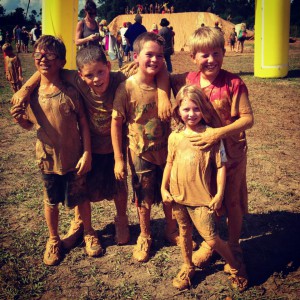
Kids have an innate appreciation for soil! Photo credit: Carrie Stevenson
Despite how much fun it can be to play in, the humble soil often gets overlooked. Mixtures of clay, sand, and loam seem less exciting when competing for attention with more charismatic natural phenomena such as colorful flowering plants or powerful top predator animals. Partially because of this status, soil scientists and agronomists declared 2015 the “International Year of Soils” with the goal of educating the general public on soil’s importance.
While most of us don’t think about soil on a regular basis, it is the literal foundation for producing healthy food and much of our clothing, along with fuel sources and many medicinal products. Without the small organisms and insects living in the soil to break things down, everything that ever died could still be slowly decaying on the surface of the earth. Soil is the primary player in recycling and making crucial nutrients such as phosphorus, nitrogen, and potassium available to plants. If you’ve ever tried to grow vegetables in the Panhandle, you know the high sand content and low nutrient levels of many of our native soils leave much to be desired. Gardeners know that a mix of organic materials is necessary to give soil enough structure, water-holding capacity, and nutrient sources to provide plant roots a healthy growing environment.
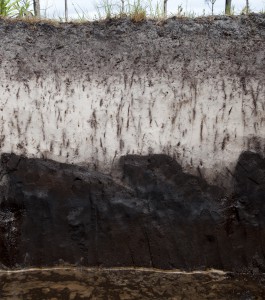
Soil profile. Photo courtesy UF/IFAS.
Soils are crucial to agricultural production, but they also play important environmental roles. On a global scale, soils are a “sink” for carbon and help combat climate change. At the same time, soils help reduce pollution through filtration and store water to recharge our drinking water aquifers. The water absorbed within healthy soils can help protect communities from both drought and flooding.
Pollution and erosion are among the biggest threats to healthy soil, and governmental agencies at all levels devote considerable funds and staff to protecting this life-giving limited natural resource. To learn more about soil and how to test for soil nutrients and pH, talk to your local Extension agent. There are many great online resources devoted to soil science, such as the Natural Resource Conservation Service’s new “Unlock the Secrets in the Soil” campaign, the USDA’s online soil surveys, and the UF IFAS Soil & Water Science Department newsletter, “Myakka.”

by Carrie Stevenson | Oct 20, 2015
Contrary to popular belief, stormwater runoff—not industrial discharge—is the primary source of water pollution in Florida. During a rain, anything on the ground can be picked up, carried via water, and taken downstream to the nearest body of water. While newer construction projects require stormwater treatment (including detention ponds or newer techniques such as pervious pavement and biofiltration), the infrastructure in older coastal communities often pipes rainwater directly into local creeks, bayous, and bays.
A large storm drain empties into Pensacola Bay. Photo Credits: Carrie T. Stevenson, IFAS Extension
Pollutants contained in stormwater vary greatly in type and potential for damage. E. coli and fecal coliform bacteria from pet waste and septic tanks frequently cause closures of local swimming holes due to high bacteria counts. Heavy metals from car exhaust, along with oil and grease from roads and parking lots can contaminate fish. Litter from yards, roadsides, and coastal areas can trap, injure, or kill wildlife. Nitrogen and phosphorus from excess fertilization and organic debris can result in water bodies with oxygen deprivation, algae blooms, and in worst case scenarios, fish kills. Even sediment and clay from dirt roads, eroding property, and construction sites can end up downstream, filling in creek bottoms or seagrass beds.
When creeks are filled with sediment, the small invertebrates that make up the bottom of the food chain are smothered, while turbidity (cloudy water resulting from sediment particles) and sedimentation in grass beds reduces the amount of sunlight reaching the grasses and prevents growth.

Pervious pavement allows rainwater to filter into the soil instead of running over parking lots. Photo Credits: Christopher J. Martinez, UF Agriculture and Biological Engineering.
The most difficult aspect of preventing stormwater pollution, also referred to as “non-point source” pollution, is that it doesn’t come from a single source but is the result of numerous cumulative impacts. However, there are many ways that individuals can reduce their unintentional contribution to this problem. When it’s time to fertilize plants, read and follow the label, and if you have questions, contact an extension agent to make sure you understand the proper amount to apply. If you live on a dirt road that crosses a creek, encourage your neighbors to agree to having it paved—many county projects are held up by a handful of homeowners who don’t see the benefits to having a rural road paved. Be sure to clean up pet waste, and if you’re on a septic system and have the capability to convert to sewer treatment, take advantage of that option.
While it can seem that these minor changes can’t make a big difference, there is much evidence to the contrary. The US Environmental Protection Agency recently recognized the success of a Florida community that took assertive stormwater pollution prevention measures. As a result of their actions, a polluted water body, Roberts Bay (Sarasota) was removed from the state’s list of impaired waters.
http://water.epa.gov/polwaste/nps/success319/fl_roberts.cfm

by Carrie Stevenson | Sep 29, 2015
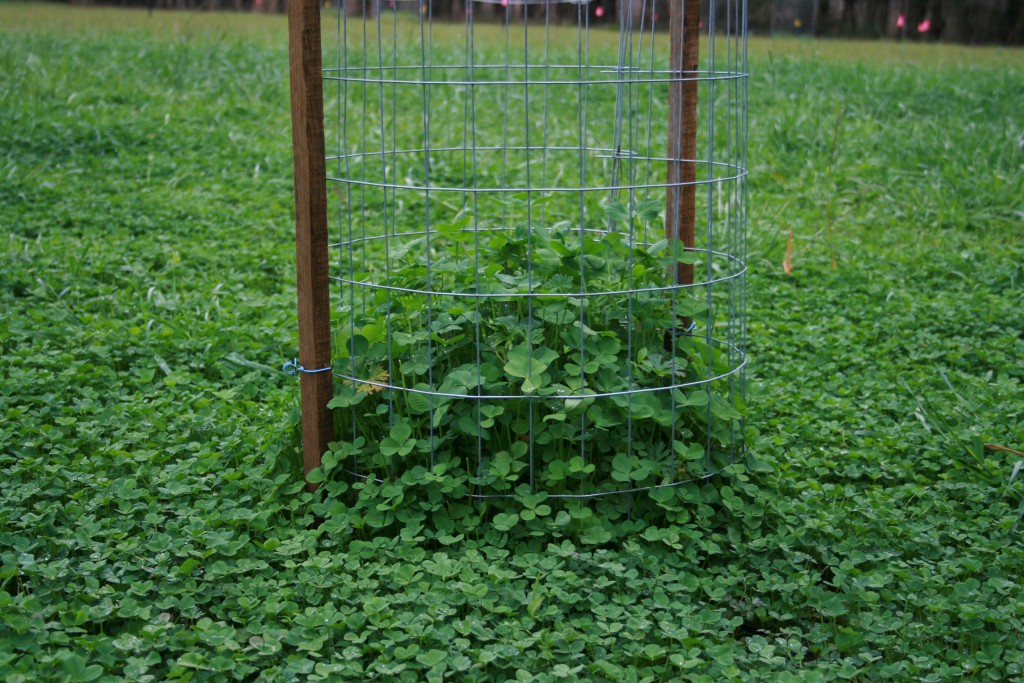
Cool Season Wildlife Food Plot. Photo by Jennifer Bearden, UF / IFAS
Many of us enhance our home landscaping with bird feeders, bird houses, bird baths and other items so that we can attract wildlife. To accomplish the same thing, many rural landowners plant wildlife food plots. While large landowners often plant several acres, food plots can work well in any sunny area and can be as small as an urban garden.
Food plot plants that do well in our area include clovers, millet, partridge pea, winter wheat, corn, sunflowers and legumes. Deer also like beggerweed and cowpeas.
If you decide to establish a wildlife food plot, you should manage it just like any other garden. The location should be sunny (a minimum of 50% sunshine is recommended) and plots often look better and wildlife will feel safer if you have a backdrop like a forest edge or tall hedgerow.
Just like any other garden, turn the soil with a garden plow or shovel and than smooth the seedbed. Seeding can be done by hand or with a handheld broadcast spreader.
Seeds should be covered lightly (1/4 to 1/2 inch in most cases) and watered as needed. In normal years watering won’t be needed, but if you get an extended dry spell you may want to give the plants additional water. Fertilizer is also recommended and will definitely give you more productivity. I have escaped that myself by growing clover in the winter for nitrogen and adding fireplace ashes to provide calcium (liming agent), potassium and phosphorus. If there is any doubt about what to apply, it is best to get a soil test and follow the recommendations for applying lime and fertilizer. Contact your local County Extension Office for more information.
I generally plant two crops in my wildlife garden–crimson clover in October (that beautiful clover you see in spring along the highways) and brown top millet in the spring after the clover dies back. I mow between seedings; this can work without tilling with some crops, if you keep the weeds under control. When I mow the millet it puts the seed on the ground and many ground feeding birds like doves move in to eat the seeds.
Speaking of gardens, the wildlife food plot makes a useful cover crop for your vegetable garden if you are taking a long vacation or just need a break for any other reason. You can also use the plants as green manure when you decide to put vegetables back in your garden.
It is always good to remember that when wildlife view your landscape, they don’t see pretty grass, flowers, shrubs and trees–they see habitat, good or bad. Food plots simply boil down to food and shelter for them.
To learn more about food for wildlife, consult this article on establishing and maintaining wildlife food sources.
Stan Rosenthal
Extension Agent
Leon County Extension Office
RosenthalS@leoncountyfl.gov











